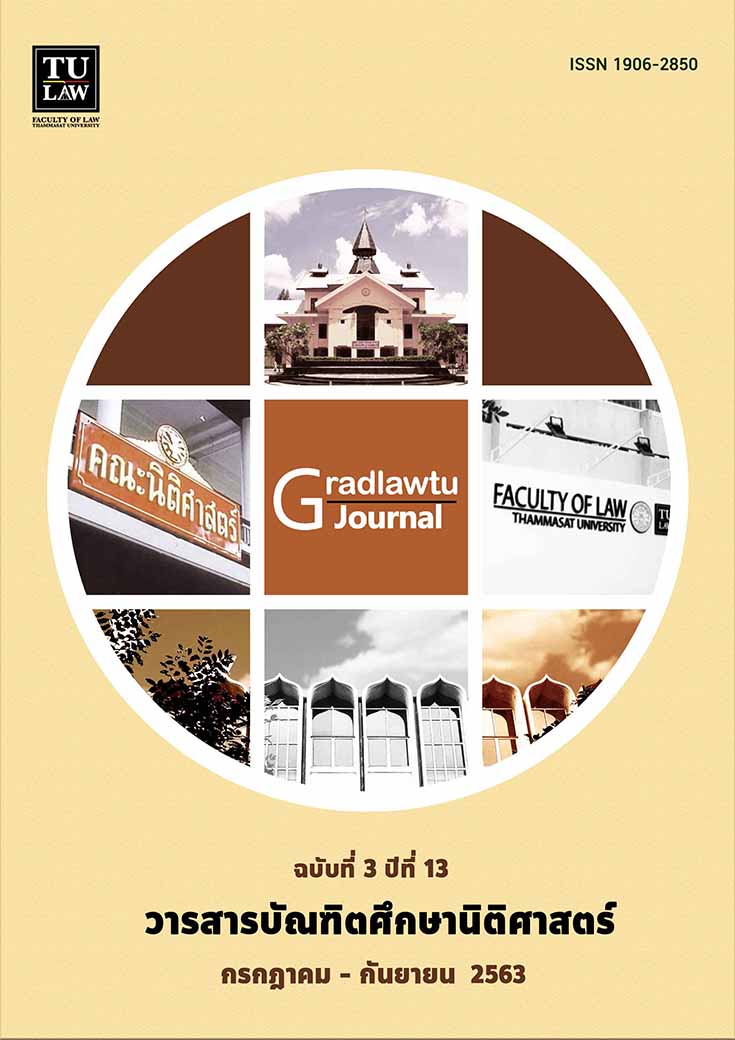คะแนนเสียงของสมาชิกสภาผู้แทนราษฎรและสมาชิกวุฒิสภาในการแก้ไขเพิ่มเติมรัฐธรรมนูญ
Main Article Content
บทคัดย่อ
บทความชิ้นนี้ได้ศึกษาปัญหาของหลักเกณฑ์เกี่ยวกับคะแนนเสียงของสมาชิกสภาผู้แทนราษฎรและสมาชิกวุฒิสภาในการแก้ไขเพิ่มเติมรัฐธรรมนูญแห่งราชอาณาจักรไทย พุทธศักราช 2560 โดยได้ศึกษาบทบัญญัติของรัฐธรรมนูญแห่งราชอาณาจักรไทย พุทธศักราช 2560 ที่เกี่ยวข้อง และเปรียบเทียบกับบทบัญญัติของรัฐธรรมนูญของประเทศฝรั่งเศส เยอรมนี ออสเตรีย และญี่ปุ่น เพื่อหาแนวทางแก้ไขปัญหาสำหรับประเทศไทยต่อไป
ผลการศึกษาพบว่ารัฐธรรมนูญแห่งราชอาณาจักรไทย พุทธศักราช 2560 ได้กำหนดให้การพิจารณาให้ความเห็นชอบร่างรัฐธรรมนูญแก้ไขเพิ่มเติมให้กระทำโดยที่ประชุมร่วมกันของรัฐสภา ซึ่งจะก่อให้เกิดปัญหาตามมา 3 ประการ คือ ประการแรก สภาผู้แทนราษฎรและวุฒิสภาต่างก็จะสูญเสียความสามารถในการปฏิบัติตามอำนาจหน้าที่ของตน ประการที่สอง กระบวนการแก้ไขเพิ่มเติมรัฐธรรมนูญจะขาดความชอบธรรมทางประชาธิปไตย และประการที่สาม ทำให้รัฐธรรมนูญอาจถูกแก้ไขเพิ่มเติมได้ง่ายกว่ากฎหมายธรรมดา นอกจากนั้นแล้ว รัฐธรรมนูญแห่งราชอาณาจักรไทย พุทธศักราช 2560 ยังได้กำหนดให้ร่างรัฐธรรมนูญแก้ไขเพิ่มเติมต้องได้รับความเห็นชอบจากสมาชิกสภาผู้แทนราษฎรฝ่ายค้านไม่น้อยกว่าร้อยละ 20 ของจำนวนสมาชิกสภาผู้แทนราษฎรฝ่ายค้านทั้งหมดเท่าที่มีอยู่ ซึ่งจะทำให้เกิดปัญหาตามมา 2 ประการคือ ประการแรก หลักเกณฑ์ดังกล่าวเป็นการคุ้มครองเสียงข้างน้อยที่ไม่ถูกต้องตามหลักการ และประการที่สอง หลักเกณฑ์ดังกล่าวมีช่องว่างที่ทำให้ร่างรัฐธรรมนูญแก้ไขเพิ่มเติมอาจผ่านความเห็นชอบของรัฐสภาไปได้ทั้ง ๆ ที่มีสมาชิกสภาผู้แทนราษฎรฝ่ายค้านเห็นชอบด้วยไม่ถึงร้อยละ 20 ของจำนวนสมาชิกสภาผู้แทนราษฎรฝ่ายค้านทั้งหมดเท่าที่มีอยู่
เพื่อที่จะแก้ไขปัญหาดังกล่าว บทความชิ้นนี้จึงได้เสนอแนะให้นำแนวทางของประเทศฝรั่งเศส เยอรมนี ออสเตรีย และญี่ปุ่นมาปรับใช้ ซึ่งสามารถกำหนดเป็นข้อเสนอแนะได้ 3 ประการดังนี้คือ ประการแรก กำหนดให้การพิจารณาและให้ความเห็นชอบแก่ร่างรัฐธรรมนูญแก้ไขเพิ่มเติมกระทำโดยสภาผู้แทนราษฎรและวุฒิสภาแยกต่างหากจากกันแทนที่จะกระทำโดยที่ประชุมร่วมกันของรัฐสภา ประการที่สอง กำหนดให้วุฒิสภาไม่มีอำนาจในการทำให้ร่างรัฐธรรมนูญแก้ไขเพิ่มเติมตกไป โดยหากวุฒิสภาไม่ให้ความเห็นชอบร่างรัฐธรรมนูญแก้ไขเพิ่มเติมให้มีผลเพียงแค่เป็นการยับยั้งร่างรัฐธรรมนูญแก้ไขเพิ่มเติมนั้นไว้ก่อนเท่านั้น และประการที่สาม ให้ยกเลิกหลักเกณฑ์ที่ว่าร่างรัฐธรรมนูญแก้ไขเพิ่มเติมต้องได้รับความเห็นชอบจากสมาชิกสภาผู้แทนราษฎรฝ่ายค้านไม่น้อยกว่าร้อยละ 20 ของจำนวนสมาชิกสภาผู้แทนราษฎรฝ่ายค้านทั้งหมดเท่าที่มีอยู่ และกำหนดให้ร่างรัฐธรรมนูญแก้ไขเพิ่มเติมจะต้องผ่านความเห็นชอบจากทั้งสภาผู้แทนราษฎรและวุฒิสภาด้วยคะแนนเสียง 2 ใน 3 ของจำนวนสมาชิกทั้งหมดเท่าที่มีอยู่ของสภานั้น ๆ
Article Details
บทความหรือข้อความคิดเห็นใด ๆ ที่ปรากฏในวารสารบัณฑิตศึกษานิติศาสตร์เป็นวรรณกรรมของผู้เขียนโดยเฉพาะคณะนิติศาสตร์ มหาวิทยาลัยธรรมศาสตร์ และบรรณาธิการไม่จำเป็นต้องเห็นด้วย
เอกสารอ้างอิง
ชมพูนุท ตั้งถาวร. กระบวนการแก้ไขเพิ่มเติมรัฐธรรมนูญและการควบคุมความชอบด้วยรัฐธรรมนูญของการแก้ไขเพิ่มเติมรัฐธรรมนูญในต่างประเทศ. กรุงเทพฯ : สถาบันพระปกเกล้า, 2556.
ฐากูร ศิริยุทธ์วัฒนา. กฎหมายรัฐธรรมนูญ : หลักพื้นฐานแห่งกฎหมายรัฐธรรมนูญและระบอบประชาธิปไตย. พิมพ์ครั้งที่ 3. กรุงเทพฯ : วิญญูชน, 2562.
ปิยบุตร แสงกนกกุล. กฎหมายรัฐธรรมนูญ : การก่อตั้งรัฐธรรมนูญและการแก้ไขรัฐธรรมนูญ. ปทุมธานี : โครงการตำราและเอกสารประกอบการสอน คณะนิติศาสตร์ มหาวิทยาลัยธรรมศาสตร์, 2560.
วรเจตน์ ภาคีรัตน์. คำสอนว่าด้วยรัฐและหลักกฎหมายมหาชน. พิมพ์ครั้งที่ 2. กรุงเทพฯ : โครงการตำราและเอกสารประกอบการสอน คณะนิติศาสตร์ มหาวิทยาลัยธรรมศาสตร์, 2559.
สมยศ เชื้อไทย. คำอธิบายหลักรัฐธรรมนูญทั่วไป. พิมพ์ครั้งที่ 2. กรุงเทพฯ : โครงการตำราและเอกสารประกอบการสอน คณะนิติศาสตร์ มหาวิทยาลัยธรรมศาสตร์, 2535.
งานวิจัย
ปูนเทพ ศิรินุพงศ์. “การแก้ไขเพิ่มเติมรัฐธรรมนูญกับการตรวจสอบความชอบด้วยรัฐธรรมนูญโดยองค์กรตุลาการ.” รายงานการวิจัย เสนอต่อ คณะกรรมการวิจัยและสัมมนา คณะนิติศาสตร์ มหาวิทยาลัยธรรมศาสตร์, 2555.
เอกสารอิเล็กทรอนิกส์
สำนักงานเลขาธิการสภาผู้แทนราษฎร. ความมุ่งหมายและคำอธิบายประกอบรายมาตราของรัฐธรรมนูญแห่งราชอาณาจักรไทย พุทธศักราช 2560. กรุงเทพฯ : สำนักงานเลขาธิการสภาผู้แทนราษฎร, 2562. https://cdc.parliament.go.th/draftconstitution2/ewt_dl_link.php?nid=1042&filename=index, 14 กุมภาพันธ์ 2563.
BOOKS
Shigenori Matsui. The Constitution of Japan: A Contextual Analysis. Oxford and Portland, Oregon : Hart Publishing, 2011.
ELECTRONIC MEDIA
Bundesrat of Germany. “Remit and status.” https://www.bundesrat.de/EN/organisation-en/mitglieder-en/mitglieder-en-node.html, January 30. 2020.
European Commission for Democracy through Law. Report on Constitutional Amendment. Strasbourg : European Commission for Democracy through Law, 2010. https://www.venice.coe.int/webforms/documents/default.aspx?pdffile=CDL-AD(2010)001-e, October 8, 2019.
French Senate. The Essentials. Paris : French Senate, 2018. https://www.senat.fr/fileadmin/Fichiers/
Images/visite/Essentiel/Essentiel_Brochure070918_EN.pdf, January 27, 2020.
. “The senatorial elections.” https://www.senat.fr/lng/en/senators/the_senatorial_
elections.html, January 27, 2020.
Republic of Austria Parliament. “The Federal Council.” https://www.parlament.gv.at/ENGL/PERK/
NRBRBV/BR/, February 3, 2020.
The House of Representatives, Japan. “Structure of the National Diet.” http://www.shugiin.go.jp/
internet/itdb_english.nsf/html/statics/guide/structure.htm, February 4, 2020.


